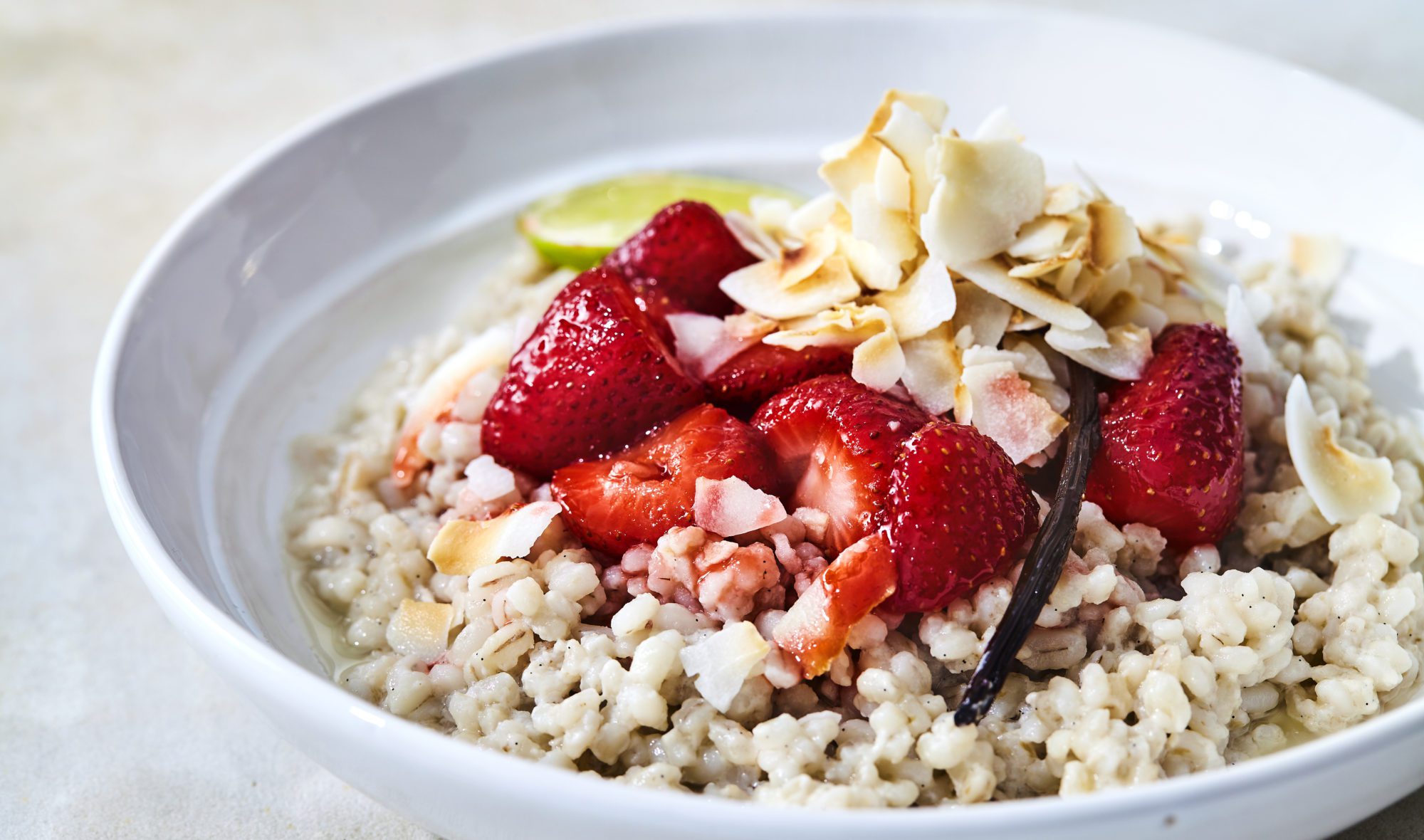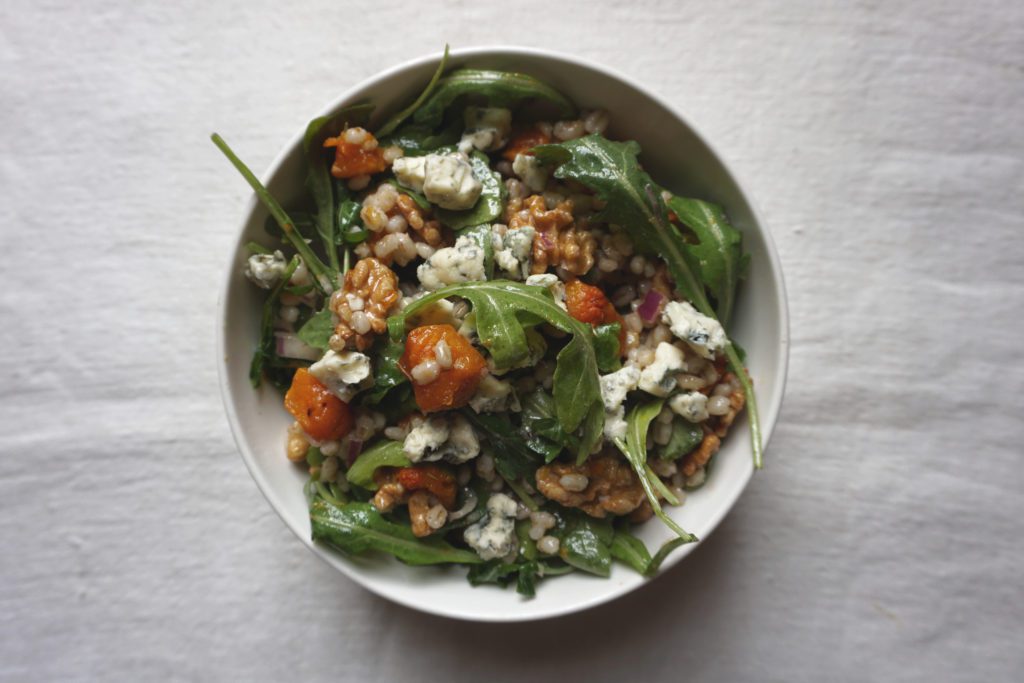
Barley comes in fourth among the most popular grains in the world, after corn, rice, and wheat. Although that would only earn it a participation ribbon at most contests, barley is still a winner! Barley has a delightfully chewy texture and mild nutty flavor. It is also highly nutritious: It’s an excellent source of molybdenum, manganese, phosphorus, and niacin, and is particularly notable in its fiber content. One of these fibers is called beta-glucan, which is a soluble fiber that has been shown to reduce cholesterol and possibly the risk of cardiovascular disease. Barley is found in several different forms: hulled barley; scotch or pot barley; and pearl barley. It can also be found as grits, cereal flakes, or flour. Barley has been cultivated for over 10,000 years, and over the millennia, has been fed to various creatures for strength and nutrition: horses, gladiators, and regular humans like you and I.
Barley comes in fourth among the most popular grains in the world, after corn, rice, and wheat.
Although that would only earn it a participation ribbon at most contests, it’s still worth trying; barley might be a winner for your mouth.
Barley has a delightfully chewy texture and mild nutty flavor. Its natural sweetness comes from its relatively high amounts of maltose, which is a sugar that creates the base of malt syrup and, when fermented, a component of beer and other alcoholic beverages.
Barley has been cultivated for over 10,000 years and is thought to have originated in North Africa and Southeast Asia. In Ancient Greece, barley was fed to athletes and warriors for strength; gladiators were known as hordearii, or “eaters of barley.”
Nutritionally, barley is particularly notable in its fiber content. One of these fibers is called beta-glucan, which is a soluble fiber that has been shown to reduce cholesterol and possibly the risk of cardiovascular disease.
Today, the world’s biggest producer of barley is Russia, followed by Germany, then France.
Barley is found in several different forms: hulled barley; scotch or pot barley; and pearl barley. It can also be found as grits, cereal flakes, or flour.
Hulled barley is the least refined version, and still contains the outer husk of the grain. Because of this, it will be chewier, more fibrous, and will take longer to cook compared to other versions.
Scotch or pot barley is hulled barley that has been polished lightly, so that most of the outer husk has been removed, but the grain’s bran and endosperm still remains.
Pearl barley is barley that has been polished to the point that only the inner starch remains. Pearl barley is to hulled barley what white rice is to brown rice. It is the most commonly eaten form of barley.
Barley grits are made from cracking barley into small pieces for quicker cooking. Barley flakes are made by pressing barley into flat shapes and can be found in quick cereals. Barley flour is made by milling barley into a fine powder, which is then used for baked goods.
All barley products have a mild, starchy, slightly nutty flavor. Hulled, pot/scotch, and pearled barley have a pleasantly chewy texture, with the latter being the softest of the bunch.
One cup of cooked pearled barley (about 157g) has 193 calories, 3.6g of protein, 0.7g of fat, 44.3g of carbohydrates, 6g of fiber, and 0.4g of sugar. Barley is an excellent source of molybdenum, manganese, phosphorus, and niacin, and a good source of zinc, magnesium, and vitamin B6.
Barley contains gluten, which is partly what gives it its chewy texture.
Barley is a very popular grain and can be found at most grocery stores, bulk food stores, and health food stores around the world.
When buying barley, shop at stores with high product turnover and, in the case of bulk food stores, covered bins. If buying packaged barley, ensure good expiration dates and choose products that don’t show any signs of moisture, which could compromise freshness.
Due to the presence of the oil-rich germ, hulled (whole grain) barley will have a shorter shelf life than pearled barley. Hulled barley should be kept in an airtight container in a dark, dry cupboard for up to three months, or in the fridge for up to six months.
Pearled barley is more stable, and may be kept in an airtight container in a dry, dark area such as a cupboard for up to a year.
Once barley is cooked, store in an airtight container in the fridge for up to five days, or freeze for up to three months.
Barley is a neutral-tasting, versatile grain, and is delicious in both sweet or savory preparations. It can be used as a base for risotto or breakfast porridges, or it can be thrown into soups, stir-frys, or salads.
Pearled barley is the most common form of barley. It’s a little less chewy and fibrous than hulled (whole) barley, but it takes less time to cook, and it’s still nutritious.
Here’s how to make it:
Add 1 cup of pearled barley to a pot with 2.5 cups of water or broth. Bring to a boil, then reduce to a simmer and allow to cook, covered, for 40-60 minutes. The barley is cooked when it’s nearly doubled in size and has a wonderful soft, chewy texture. Once cooked, fluff the grains, and set aside to cool. Then, add to your favorite recipe. This ratio will yield about 3.5 cups of cooked barley.

This hearty, warmed salad is great for the colder months when you shudder at the thought of a cold, light salad. With toasty, savoury flavors from roasted walnuts, blue cheese, nutty barley, and spicy arugula, you’ll love this salad all year round.
Prep Time: 30 minutes Cook Time: 90 minutes Yield: 4 servings
First, cook the barley: Add 1 cup of pearled barley to a pot with 2.5 cups of water or broth. Bring to a boil, then reduce to a simmer and allow to cook, covered, for 40-60 minutes. This ratio will yield about 3.5 cups of cooked barley. Once cooked, fluff the grains, and set aside to cool.
While the barley is cooking, roast the butternut squash: Preheat the oven to 400 degrees Fahrenheit. Toss the peeled, cubed butternut squash in 2 teaspoons of olive oil. Line a baking tray with parchment paper, and spread the squash cubes out in an even layer, being careful not to crowd the pieces. Place in the oven and cook for 20 minutes, then remove from the oven, toss the pieces for even baking, then place back in the oven for another 10-15 minutes. Squash cubes are ready when they are soft in the middle and golden at the edges. Once they are done, set them aside to cool.
While the barley/butternut is cooking, you can also make the dressing: Add the juice of 1/2 lemon, 1/4 cup olive oil, dijon, maple syrup, thyme, and sea salt to a jar and whisk to combine. Set aside.
Once the barley and squash have cooked and cooled, add them both to a large bowl with the dressing, red onion, walnuts, and arugula, and toss to combine. Portion into individual bowls, top with crumbled blue cheese, and serve.
Precision Nutrition’s Encyclopedia of Food expands every single month as we highlight new foods and showcase beautiful food photography. If you’d like to stay up to date, simply click this link. From there, we’ll send you a FREE copy of our recipe book. We’ll also let you know when new and delicious foods are added to the site.
Barley comes in fourth among the most popular grains in the world, after corn, rice, and wheat. Although that would only earn it a participation ribbon at most contests, barley is still a winner! Barley has a delightfully chewy texture and mild nutty flavor. It is also highly nutritious: It’s an excellent source of molybdenum, manganese, phosphorus, and niacin, and is particularly notable in its fiber content. One of these fibers is called beta-glucan, which is a soluble fiber that has been shown to reduce cholesterol and possibly the risk of cardiovascular disease. Barley is found in several different forms: hulled barley; scotch or pot barley; and pearl barley. It can also be found as grits, cereal flakes, or flour. Barley has been cultivated for over 10,000 years, and over the millennia, has been fed to various creatures for strength and nutrition: horses, gladiators, and regular humans like you and I.